Problem 1. Suppose demand for glasses is very inelastic and the supply of glasses is relatively elastic. If the government imposes an excise tax on glasses, which of the following is most likely to occur?
a. Consumers will bear a greater tax incidence than producers.
b. Producers will bear a greater tax incidence than consumers.
Problem 2. Suppose that the market basket costs $125 in 2010 and that the inflation rate between 2010 and 2015 was 20%. From this information we can conclude that the market basket costs ________ in 2015.
a. 145
b. 150
Problem 3. Kim consumes two goods, books and pizzas. If the price of books increases, while the price for pizzas stays constant, the slope of Kim’s budget line will become: (put books on the x-axis and pizzas on the y-axis)
a. Steeper.
b. Flatter.
Problem 4. Assume that the marginal cost of producing Easter Bunnies is always increasing as the quantity of Easter Bunnies increases. You also know that currently the marginal cost of the current level of output is below the average total cost of producing this level of output and that this will still be true if the firm produces one more Easter Bunny. Given this information, what happens to average total cost when the firm decides to produce one more Easter Bunny?The average total cost will:
a. Increase.
b. Decrease.
Problem 5. Sue likes to eat cheese curds and make long-distance phone calls. Currently, she has no cell phone and must use a pay phone to make calls. Sue’s income is $200. A dish of Cheese curds costs $10. Here is the information about the cell phone plan that Sue has.The cell phone service plan costs $50. For the $50, Sue gets 10 long-distance calls to start. After the first 10 long distance calls, Sue may pay for additional long-distance calls at a price of $1 per call. Given this information and holding everything else constant, what are the coordinates for the kink point in the budget line? (Hint: First, subtract $50 from Sue’s income)
a. 15 cheese curds, 10 phone calls
b. 5 cheese curds, 150 phone calls
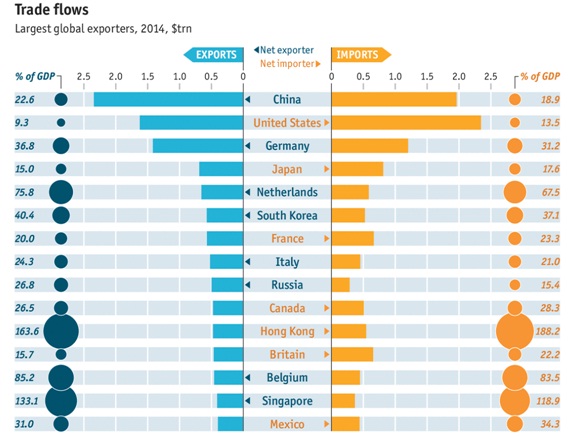
Problem 6. Based on the graph above, which of the following statements is true?
a. The largest global exporter (as a percentage of GDP) is Hong Kong.
b. The trade surplus (the difference between the level of exports and the level of imports)for the United States is greater than the trade surplus for Belgium.
Use the following information to answer the next two (2) questions.
Dunia spends all her income on two goods X and Y. The price of each unit of X or of Y is $1, and it’s known that Dunia is consuming 5 units of each good (which means, Dunia’s initial income is $10). The income elasticity of good X is 2.
Problem 7. How many units of good Y would Dunia consume if you knew that Dunia’s income increased by 10%?
a. 5 units of good Y
b. 5.5 units of good Y
Problem 8. Assume that the price of good X is still $1 and that Dunia's income is at its initial level of $10. Suppose you are told that Dunia decides to buy 10 units of good Y when the price of good Y drops to $0.50. Given this information and holding everything else constant, what is the cross price elasticity of good X for good Y?
a. 0
b. 0.5
Problem 9. The government of Happyland wants to cancel the tariff on imported stuffed animals and replace it with an import quota of 4000 units. Holding everything else constant, if you know that Happyland was initially importing 5000 stuffed animals with the imposed tariff, what would happen if the government changes the policy and implements animport quota of 4000 units instead? The domestic producer surplus in this market will:
a. Increase.
b. Decrease.
MULTIPLE CHOICE QUESTIONS (20 QUESTIONS)
Use the following information to answer the next two (2) questions.
Consider the market for pizza in Madison that can be described by the following market demand and market supply curves where P is the price per pizza and Q is the quantity of pizzas:
Market Demand: P = 15 - (1/3)Q
Market Supply: P = (2/3)Q
Due to a recent report linking pizza consumption to heart disease, the government decides to impose an excise tax of $6 per pizza to reduce the quantity of pizza eaten in Madison.
Problem 10. Given this information and holding everything else constant, what is the equilibrium price that consumers pay and the equilibrium quantity of pizza after the excise tax is imposed?
a. P* = 15 per pizza, Q* = 10 pizzas
b. P* = 10 per pizza, Q* = 15 pizzas
c. P* = 9 per pizza, Q* = 12 pizzas
d. P* = 12 per pizza, Q* = 9 pizzas
Problem 11. What is the deadweight loss caused by the imposition of the excise tax?
a. DWL = $9
b. DWL = $12
c. DWL = $18
d. DWL = $36
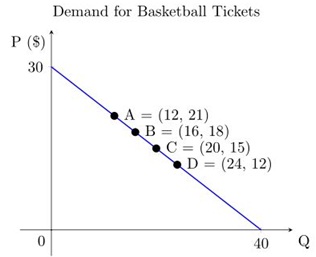
Problem 12. Using the graph above, suppose the basketball team would like to maximize total revenues. At which point will revenue be maximized?
a. Point A
b. Point B
c. Point C
d. Point D
Problem 13. The demand for oranges in Wisconsin is given by the following equation where P is the price per unit of oranges and Q is the quantity of units of oranges:
Q = 100 – 0.25P
Consider two points on the demand curve for oranges in Wisconsin. At point A, the price for oranges is $100 per unit of oranges, and at point B the price for oranges is $300 per unit of oranges. Using the arc elasticity formula, calculate the price elasticity of demand for oranges from point A to point B.
a. 0.33
b. 1
c. 1.5
d. 3
Use the following information to answer the next two (2) questions.
The demand and supply for Fish and Chips in the Principality of Sealand is given by the following equations where P is the price per unit of fish and Q is the number of units of fish:
Demand: Q = 20 – 0.5P
Supply: Q = 0.5P
The price of Fish and Chips on the world market is $4 per unit of fish. Due to Sealand’s small size, Sealand's activities have no impact on the world price of fish.
Problem 14. The prince of Sealand decides to impose an import quota on Fish and Chips. He plans to sell the import license at a price that maximizes the revenue he gets from the proposed import quota. Given this information and holding everything else constant, what should the import quota be?
a. An import quota of 4 units will maximize the revenue from selling the import license.
b. An import quota of 6 units will maximize the revenue from selling the import license.
c. An import quota of 8 units will maximize the revenue from selling the import license.
d. An import quota of 10 units will maximize the revenue from selling the import license.
Problem 15. Due to complaints from the people of Sealand, the prince is forced to change the import quota of Fish and Chips, such that the new quota maximizes consumer surplus. What should the new quota level be in order to reach this goal? To maximize consumer surplus, the new import quota level should be set at:
a. 0 units of imported fish.
b. 6 units of imported fish.
c. 12 units of imported fish.
d. 18 units of imported fish.
The following graph shows the cost curves for a manufacturing firm,
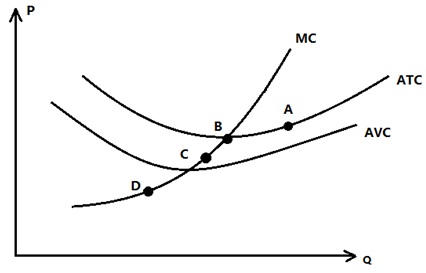
Problem 16. Which of the following statements is incorrect?
a. The firm will never operate at point A.
b. The firm is making a positive economic profit at point B.
c. The firm is incurring a loss at point C.
d. In the short run, the firm will close down at point D.
Problem 17. Erzurum is a town with many tea shops. A group of economics students runs one of the shops, called Cayevi. The total and marginal cost curves for this tea shop are as given by the following equations where q is the quantity of units of tea sold by Cayevi:
TC= 0.2q^2+20
MC= 0.4q
Given this information, at what price and quantity will average total cost equal marginal cost?
a) $1 per unit of tea, 2.5 units of tea
b) $2 per unit of tea, 5 units of tea
c) $3 per unit of tea, 7.5 units of tea
d) $4 per unit of tea, 10 units of tea
Problem 18. Maruchan, the ramen noodle company, faces the following demand curve where P is the price per unit of ramen noodles and Q is the quantity of units of ramen noodles:
P = 100 – 2Q
Suppose the company pursues a pricing strategy that sets its price at that level where total revenue is maximized. We will refer to this price as P*.
Now, assume that the demand curve for Maruchan ramen shifts to the right at every price due to the increasing popularity of ramen noodles. Despite this demand shift, the company continues to sell its product for the same price. Given this information and holding everything else constant, what is the current point elasticity of demand for Maruchan ramen at P*?
a. Elasticity > 1
b. Elasticity = 1
c. Elasticity < 1
d. This question cannot be answered from the provided information.
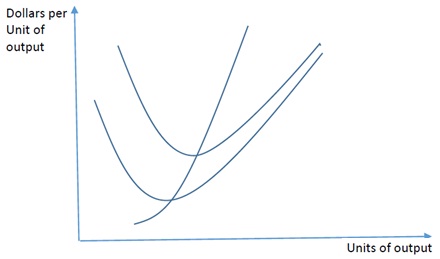
Problem 19. Based on the graph above of a firm's cost curves, which of the following statements is true?
a. The firm depicted in this graph has fixed costs.
b. This firm's variable cost initially decreases as output increases and then it increases as output continues to increase.
c. This firm's marginal cost is constant as output increases.
d. This firm's marginal cost is decreasing as output increases.
Use the following information to answer the next two (2) questions.
The market basket for the following economy is composed of 10 loaves of bread and 5 gallons of milk. Assume that base year is 2010 and a CPI is computed on a 100 point scale. Answer the following two questions based on the table below. (Note that you can fill the entire rows and columns by using what you are given in the question.)

Problem 20. What is the nominal price of bread in 2011?
a. $5.00
b. $6.00
c. $8.50
d. $8.00
Problem 21. Given the above information and holding everything else constant, what is the approximate annual inflation rate for 2012?
a. 37%
b. 33%
c. 35%
d. 40%
Use the following information to answer the next three (3) questions.
Problem 22. Woody’s utility function is given by the following equation: U(x,y)=xy
This equation tells us that Woody's Utility, U, is dependent upon how much of good X and good Y he consumes. You are also told that Woody's marginal utility from consuming an additional unit of good X and his marginal utility from consuming an additional unit of good Y are given by the equations:
MUx = y and MUy = x.
Suppose you know that Woody maximizes his utility by choosing to consume 10 units of X and 20 units of Y. Given this information, which of the following combinations of prices and income are possible?
a) Px= $3 per unit of good X, Py= $3 per unit of good Y and income= $90
b) Px= $3 per unit of good X and Py= $1.50 per unit of good Y and income= $60
c) Px= $1.50 per unit of good X and Py= $3 per unit of good Y and income= $75
d) Px= $1.50 per unit of good X and Py= $1.50 per unit of good Y and income= $45
Problem 23. Given all of the above information and your work in the last problem, how many units of each good will Woody choose to consume if his income increases by $30?
a) 15 units of good X and 30 units of good Y
b) 12.5 units of good X and 25 units of good Y
c) 17.5 units of good X and 35 units of good Y
d) 20 units of good X and 40 units of good Y
Problem 24. Given this information, the substitution effect of the increase in Woody’s income is equal to ______ and the income effect is equal to _________:
a) An increase of 2.5 units of X; an increase of 5 units of Y
b) An increase of 7.5 units of X; an increase of 15 units of Y
c) An increase of 5 units of X; an increase of 10 units of Y
d) Zero; an increase of 5 units of Xand 10 units of Y
Problem 25. You are given the following equations that describe the domestic supply and the domestic demand for t-shirts where P is the price per shirt and Q is the quantity of shirts:
Domestic Demand: P = 10 - (1/2)Q
Domestic Supply: P = (1/2)Q
If the world price of a t-shirt is $10 per t-shirt, then which of the following statements is true if this market is opened to trade?
a. The country will import 5 t-shirts.
b. The country will export 10 t-shirts.
c. Domestic suppliers will not be able to produce enough t-shirts to supply the domestic demand for shirts.
d. Domestic suppliers will supply t-shirts only to foreign consumers.
Use the following information to answer the next three (3) questions.
Let's remember the following question from the first midterm.
The former Soviet Union (U.S.S.R.) economy was based on a system of state ownership of all forms of production with centralized administrative planning determining the types and quantities of goods produced. Centralized planners determined prices in this system. Assume that the following equations describe the domestic market demand and market supply in the USSR shoe market where P is the market price in Rubles per pair of shoes and Q is the quantity of pairs of shoes:
Domestic market demand for shoes in the USSR: P=100-Q
Domestic market supply of shoes in the USSR: P= (1/3)Q
Now assume that the centralized committee allows international trade instead of setting an effective price ceiling for each pair of shoes. You are also told that the world price for each pair of shoes is 10 Rubles.
Problem 26. What would happen to the consumer surplus if the central committee allows international trade and opens this market for shoes to the world market? The domestic consumer surplus in this market will increase relative to the closed market consumer surplus by:
a. $2475.00
b. $1237.50
c. $2825.00
d. $1412.50
Problem 27. Suppose that just before the central committee announces its decision to allow international trade some people in the USSR travel to Yugoslavia and buy 40 pairs of shoes to bring back and sell in the USSR. The central committee realizes that these citizens have impacted this market. Which of the following graphs best represents this new situation?
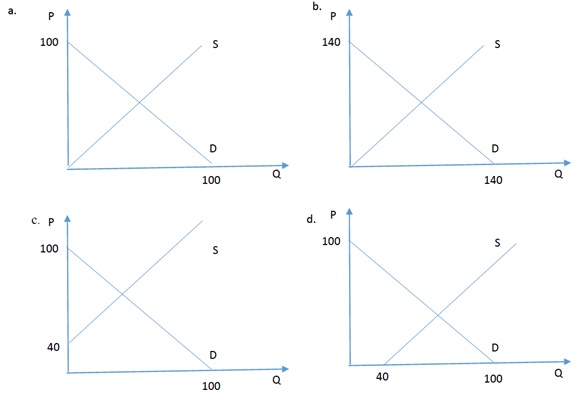
Problem 28. After this change in the market for shoes in the USSR, the central committee issuestheir edict allowing international trade, but they also decide to simultaneously impose a tariff on this market. If the central committee wishes to maximize the government's revenue from this tariff, which of the following tariffs would be best to reach this goal?
a. A tariff of $2.50 per pair of imported shoes
b. A tariff of $5.00 per pair of imported shoes
c. A tariff of $7.50 per pair of imported shoes
d. A tariff of $10.00 per pair of imported shoes
Problem 29. Hank’s total utility in terms of money (for example U=10 means Hank is willing to pay up to $10for the bundle) is given in the following table.
Number of Espresso Shots Consumed Utility, U, from consuming Espresso Shots
5 20
6 26
8 29
9 30
If the price of one shot of Espresso is $2, how many shots of Espresso will Hank consume given the above table and information?Recall that Hank will want to compare his marginal utility to the price of the good when making this decision.
a. 5 shots of Espresso
b. 6 shots of Espresso
c. 8 shots of Espresso
d. 9 shots of Espresso